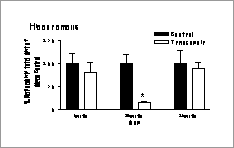A1-42 alters akt activity via α7 nicotinic and n-methyl D-aspartate receptors: implications for alzheimer’s disease †††. Amyloid, Aβ is believed to be associated with the neuronal pathologies seen in Alzheimer’s disease (AD) yet its pharmacology remains poorly understood. A b binds to the α7 nicotinic receptor, α7nAChR, (Wang HY et al., 2000), and nicotinic stimulation recruits phosphatidylinositol 3-kinase, (PI3K) and activates Akt, (Kihara T et al., 2001). Akt is implicated in NMDAR long term potentiation, LTP, (Sanna PP et al. 2002). The aim of this study was to determine the role of Aβ, α7 nAChR and NMDAR on Akt. 40μg homogenates were prepared, (Perkinton MS et al. 2002), from the hippocampus of TAS10 mice, (carrying the human Aβ precursor protein with Swedish K670N-M671L mutation showing plaque deposition from 12 months and an age-dependent elevation of Aβ levels, (Richardson J et al. 2003)) and littermate controls at 7, 13 and 18 months. 25μg homogenates were prepared from 6 day in vitro primary cortical cultures of NIH Swiss mouse embryos, gestation day 14. Cultures were incubated for 5min with 10nM methyllycaconitine, MLA, (α7 antagonist), 10μM ifenprodil, IF, (NMDA antagonist) or vehicle, followed by 10-60min with 400nM Aβ1-42 , (California Peptides Inc.). Samples were subjected to SDS-PAGE and transferred to nitrocellulose membranes. Ser473 phospho Akt and Total Akt were detected by appropriate antibodies (1:1000 dilution; New England Biolabs). Membranes were exposed to horseradish peroxidase conjugated secondary antibody before detection using Enhanced Chemiluminescence reagents. Blots were scanned/ quantified using Bioimage Intelligent Quantifier densitometry and phosphoAkt/ total Akt calculated and compared using the Student’s t-test.
Figure 1. Percentage ratio pAkt/ total Akt of mean control in the TAS10 hippocampus, at 7, 13 and 18 months. Values are mean ± s.e.mean, n=10. * = P<0.05. pAkt was reduced in the 13month TAS10 hippocampus by 80%. In neuronal cultures, 10min Aβ increased pAkt and was inhibited by both MLA and IF. Akt phosphorylation was not seen at 60min suggesting longer protocols inhibit stimulation. This data suggests Aβ modulates Akt activity via α7nAChRs and NMDARs and in the TAS10 hippocampus and possibly the AD brain, this is chronically impaired in some manner.
Kihara T et al., (2001) J. Biol. Chem. 276: 13541-13546. |


